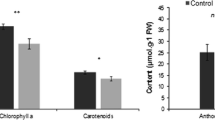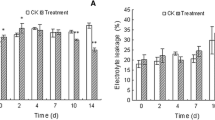Abstract
The difference between drought tolerance of juvenile and mature leaves of the winter-deciduous dwarf shrub bilberry (Vaccinium myrtillus L.) from a northern boreal environment was investigated. It was hypothesised that mature leaves are more drought sensitive than juvenile leaves. Bilberry plants were allowed to dry out by excluding irrigation when leaves were at juvenile and mature stages. Tissue water content decreased at both phenological stages, but the response was more pronounced in the mature leaves. Anthocyanin concentrations increased as the tissue water content decreased, and again this occurred to a greater extent in the mature leaves. Chlorophyll concentrations decreased only marginally at the juvenile stage, while the decrease was significant in the mature leaves. Chlorophyll degradation was enhanced by drought stress. Soluble proteins decreased and protein oxidation increased in the mature leaves, and degradation of oxidised proteins increased in the drought-stressed plants. The results suggest that leaves of bilberry are more sensitive to drought stress at the mature stage, and that drought stress accelerates senescence at the mature stage. The significance of the results is that dry periods during the juvenility of leaves are not as detrimental as they may be later in summer. In addition, the strategy of a winter-deciduous plant is obviously to protect its perennial parts from severe drought by accelerated leaf senescence at the mature stage. Therefore, the deciduous life form may provide an excellent adaptation against drought also in northern ecosystems. The role of anthocyanins in photoprotection under drought stress is also discussed.





Similar content being viewed by others
References
ACIA (2005) Arctic climate impact assessment. Cambridge University Press, Cambridge
Alscher RG, Donahue JL, Cramer CL (1997) Reactive oxygen species and antioxidants: relationships in green cells. Physiol Plant 100:224–233
Anonymous (1991) Climatological statistics in Finland 1961–1990. Supplement to the meteorological yearbook of Finland vol. 90. The Finnish Meteorological Institute, Helsinki
Borchert R (2003) Environmental control of vegetative phenology in tropical dry forest trees. In: Larcher W (ed) Physiological plant ecology. Springer-Verlag, Berlin, pp 337–340
Bradford MM (1976) A rapid and sensitive method for the quantitation of microgram quantities of protein utilizing the principle of protein-dye binding. Anal Biochem 72:248–254
Chalker-Scott L (1999) Environmental significance of anthocyanins in plant stress responses. Photochem Photobiol 70:1–9
Close DC, Beadle CL (2003) The ecophysiology of foliar anthocyanin. Bot Rev 69:149–161
Crawford RMM (1989) Studies in plant survival. Blackwell Scientific Publications, Oxford
de Kroon H, van der Zalm E, van Rheenen JWA, van Dijk A, Kreulen R (1998) The interaction between water and nitrogen translocation in a rhizomatous sedge (Carex flacca). Oecologia 116:38–49
Evans JR (1983) Nitrogen and photosynthesis in the flag leaf of wheat (Triticum aestivum L.). Plant Physiol 72:297–302
Farrant JM (2000) Comparison of mechanisms of desiccation tolerance among three angiosperm resurrection plants. Plant Ecol 151:29–39
Foyer CH, Noctor G (2005) Oxidant and antioxidant signalling in plants: a re-evaluation of the concept of oxidative stress in a physiological context. Plant Cell Environ 28:1056–1071
Freitas H (1997) Drought. In: Prasad MNV (ed) Plant ecophysiology. Wiley, New York, pp 129–149
Gogorcena Y, Iturbe-Ormaetxe I, Escuredo PR, Becana M (1995) Antioxidant defences against activated oxygen in pea nodules subjected to water stress. Plant Physiol 108:753–759
Hacke UG, Sperry JS, Pittermann J (2000) Drought experience and cavitation resistance in six shrubs from the Great Basin, Utah. Basic Appl Ecol 1:31–41
Hadfield KA, Bennet AB (1997) Programmed senescence of plant organs. Cell Death Differ 4:662–670
Hoch WA, Zeldin EL, McCown BH (2001) Physiological significance of anthocyanins during autumnal leaf senescence. Tree Physiol 21:1–8
Hodges DM, DeLong JM, Forney CF, Prange RK (1999) Improving the thiobarbituric acid-reactive-substances assay for estimating lipid peroxidation in plant tissues containing anthocyanin and other interfering compounds. Planta 207:604–611
Huffaker RC (1990) Proteolytic activity during senescence of plants. New Phytol 116:199–231
Iturbe-Ormaetxe I, Escuredo PR, Arrese-Igor C, Becana M (1998) Oxidative damage in pea plants exposed to water deficit or paraquat. Plant Physiol 116:173–181
Kicheva MI, Tsonev TD, Popova LP (1994) Stomatal and non-stomatal limitations to photosynthesis in two wheat cultivars subjected to water stress. Photosynthetica 30:107–116
Kikuzawa K (1991) A cost-benefit analysis of leaf habit and longevity of trees and their geographical pattern. Am Nat 138:1250–1263
Kitajima K, Mulkey SS, Samaniego M, Wright SJ (2002) Decline of photosynthetic capacity with leaf age and position in two tropical pioneer tree species. Am J Bot 89:1925–1932
Koonjul PK, Farrant JM, Brandt WF, Lindsey GG (2000) Isolation and characterisation of chloroplasts from Myrothamnus flabelliolius Welw. J Plant Physiol 156:584–594
Kozlowski TT, Kramer PJ, Pallardy SG (1991) The physiological ecology of woody plants. Academic Press, Inc., New York
Kumar GNM, Houtz RL, Knowles RN (1999) Age-induced protein modifications and increased proteolysis in potato seed tubers. Plant Physiol 119:88–99
Lambers H, Chapin FS, Pons TL (1998) Plant physiological ecology. Springer-Verlag, New York
Larcher W (2003) Physiological plant ecology, 4th edn. Springer-Verlag, Berlin
Levine RL, Garland D, Oliver CN, Amici A, Climent I, Lenz A, Ahn B, Shaltiel S, Stadtman ER (1990) Determination of carbonyl content in oxidatively modified proteins. Methods Enzymol 186:464–478
Levine RL, Willams JA, Stadtman ER, Shacter E (1994) Carbonyl assays for determination of oxidatively modified proteins. Methods Enzymol 233:346–357
Lüttge U (2008) Physiological ecology of tropical plants, 2nd edn. Springer-Verlag, Berlin
Marchand PJ (1996) Life in the cold. An introduction to winter ecology, 3rd edn. University Press of New England, Hanover
Merzlyak MN, Chivkunova OB, Solovchenko AE, Naqvi KR (2008) Light absorption by anthocyanins in juvenile, stressed, and senescing leaves. J Exp Bot 59:3903–3911
Meshcheryakov A, Steudle E, Komor E (1992) Gradients of turgor, osmotic pressure, and water potential in the cortex of the hypocotyl of growing Ricinus seedlings. Plant Physiol 98:840–852
Moran JF, Becana M, Iturbe-Ormaetxe I, Frechilla S, Klucas RV, Aparicio-Tejo P (1994) Drought induces oxidative stress in pea plants. Planta 194:346–352
Munné-Bosch S, Alegre L (2004) Die and let live: leaf senescence contributes to plant survival under drought stress. Func Plant Biol 31:203–216
Nakano R, Ishida H, Makino A, Mae T (2006) In vivo fragmentation of the large subunit of ribulose-1, 5-bisphosphate carboxylase by reactive oxygen species in an intact leaf of cucumber under chilling-light conditions. Plant Cell Physiol 47:270–276
Parry MAJ, Andralojc PJ, Khan S, Lea PJ, Keys AJ (2002) Rubisco activity: effects of drought stress. Ann Bot 89:833–839
Roy H (1989) Rubisco assembly: a model system for studying the mechanism of chaperonin action. Plant Cell 1:1035–1042
Smart CM (1994) Gene expression during leaf senescence. New Phytol 126:419–448
Sobrado MA (1986) Aspects of tissue water relations and seasonal changes of leaf water potential components of evergreen and deciduous species coexisting in tropical dry forests. Oecologia 68:413–416
Sobrado MA (1993) Trade-off between water transport efficiency and life-span in a tropical dry forest. Oecologia 96:19–23
Soukupová J, Cvikrová M, Albrechtová J, Rock BN, Eder J (2000) Histochemical and biochemical approaches to the study of phenolic compounds and peroxidases in needles of Norway spruce (Picea abies). New Phytol 146:403–414
Tahkokorpi M, Taulavuori K, Laine K, Taulavuori E (2007) After-effects of drought-related winter stress in previous and current year stems of Vaccinium myrtillus L. Environ Exp Bot 61:85–93
Taulavuori E, Hellström E-K, Taulavuori K, Laine K (2001) Comparison of two methods used to analyse lipid peroxidation from Vaccinium myrtillus (L.) during snow removal, reacclimation and cold acclimation. J Exp Bot 52:2375–2380
Taulavuori E, Tahkokorpi M, Taulavuori K, Laine K (2004) Anthocyanins and glutathione S-transferase activities in response to low temperature and frost hardening in Vaccinium myrtillus (L.). J Plant Physiol 161:903–911
Turner IM (1994) Schlerophylly: primarily protective? Funct Ecol 8:669–675
Valladares F, Dobarro I, Sánchez-Gómez D, Pearcy RW (2004) Photoinhibition and drought in Mediterranean woody saplings: scaling effects and interactions in sun and shade phenotypes. J Exp Bot 56:483–494
Vanacker H, Sandalio LM, Jiménez A, Palma JM, Corpas FJ, Mesequer V, Gómez M, Sevilla F, Leterrier M, Foyer CH, del Río LA (2006) Roles for redox regulation in leaf senescence of pea plants grown on different sources of nitrogen nutrition. J Exp Bot 57:1735–1745
Webber AN, Nie GY, Long SP (1994) Acclimation of photosynthetic proteins to rising atmospheric CO2. Photosynth Res 39:413–425
Wellburn A (1994) The spectral determination of chlorophylls a and b, as well as total carotenoids, using various solvents with spectrophotometers of different resolution. J Plant Physiol 144:307–313
Zellnig G, Perktold A, Zechmann B (2009) Fine structural quantification of drought-stressed Picea abies (L.) organelles based on 3D reconstructions. Protoplasma. doi:10.1007/s00709-009-0058-3
Acknowledgements
The Thule Institute, University of Oulu, as well as the Jenny and Antti Wihuri Foundation, the Finnish Cultural Foundation and the Alfred Kordelin Foundation are thanked for financial support. The Finnish Meteorological Institute is acknowledged for the precipitation data.
Conflicts of interest
The authors declare that they have no conflict of interest.
Author information
Authors and Affiliations
Corresponding author
Additional information
Marjaana Tahkokorpi—Joint first authorship
Rights and permissions
About this article
Cite this article
Taulavuori, E., Tahkokorpi, M., Laine, K. et al. Drought tolerance of juvenile and mature leaves of a deciduous dwarf shrub Vaccinium myrtillus L. in a boreal environment. Protoplasma 241, 19–27 (2010). https://doi.org/10.1007/s00709-009-0096-x
Received:
Accepted:
Published:
Issue Date:
DOI: https://doi.org/10.1007/s00709-009-0096-x




